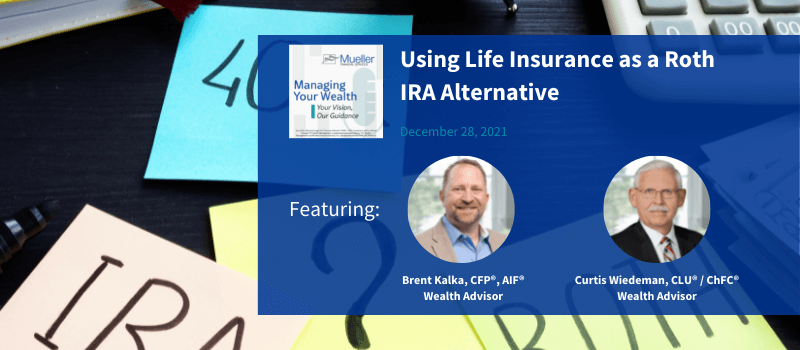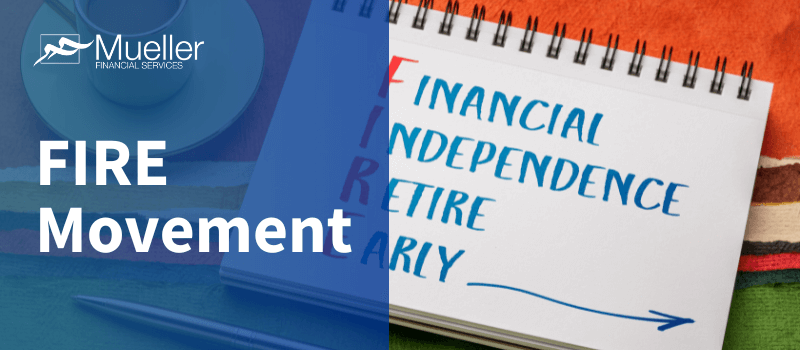
Podcast: Life Insurance as a Roth IRA Alternative
By Mueller Financial Services, December 28, 2021
Join Brent Kalka, CERTIFIED FINANCIAL PLANNER™ professional and Accredited Investment Fiduciary®, Shareholder/Wealth Advisor, and Curtis Wiedeman, CLU® / ChFC®, recently retired Mueller Financial Services Wealth Advisor for an in-depth discussion on using Life Insurance as a Roth IRA alternative as part of your retirement savings plan.
A Roth IRA or 401(k) plan is a simple place to start when planning for retirement. But, what happens when you have maxed out your contributions or are looking for that next step to enhance your long-term savings strategy? Life Insurance may be an appealing alternative to your Roth IRA.
Listen Now:
[buzzsprout episode=’9560706′ player=’true’]
For more information, please contact:

Brent Kalka, CERTIFIED FINANCIAL PLANNER™ professional and Accredited Investment Fiduciary®
Shareholder/Wealth Advisor
bkalka@muellersolutions.com
847.649.8805

Curtis Wiedeman, CLU® / ChFC®
Retired Wealth Advisor
General Agent
Episode Transcript:
[00:00.00] Emily: Hi everyone, you’re listening to “Managing Your Wealth: Your Vision, Our Guidance,” the Mueller Financial Services, Inc. Podcast.
I’m Emily and today I’m with Curtis Wiedeman and Brent Kalka, to talk about retirement planning and more specifically, using life insurance as a Roth alternative. But before we get into the topic, let’s do some introductions.
Curtis is a Chartered Life Underwriter® and Chartered Financial Consultant® with over 40 years of experience in the financial services industry. As a wealth advisor at Mueller Financial Services, he specializes in offering customized retirement asset preservation strategies and estate planning solutions to small and mid-sized business owners and self-employed individuals. Curtis seeks to find strategies that are customized to his clients, regardless of their unique situation, with special interest in the firm’s approach on life insurance and the protection and preservation of assets, long-term care, tax efficient, charitable giving opportunities, and business succession planning strategies.
Brent is a CERTIFIED FINACIAL PLANNER™ professional and Accredited Investment Fiduciary® with Mueller Financial Services. As a shareholder and wealth advisor, Brent oversees the day-to-day operations of the firm and leads the investment committee and retirement consulting practice within the firm. And lastly, he is dedicated to helping individuals understand and take action to address their personal financial planning and retirement needs.
Brent, Curtis — Thank you so much for joining me today.
Curtis, could you just give me a brief overview of using life insurance as a Roth alternative?
[00:01:44] Curtis: Yes. Those are a lot of questions that we’ve been getting lately, as we work with people that are trying to save the maximum that they can for retirement.
A lot of times they get to the point where you can only put so much into your 401(k), and you max it out. Or even a lot of times, people, because of their income limits, aren’t able to contribute to a Roth IRA. So, they lose that advantage of having the tax-deferred growth that you would in a retirement plan, such as a 401(k) or a Roth.
And the problem that this creates is when you use after tax type investments, is even though you can still invest in the mutual funds, or any type of investment, you end up with dividends and capital gains. And in the end, if you want to get out of them, you have to sell those and pay taxes on all the gains.
So, you lose a lot of that tax preference that you have in retirement plans. And that’s why now we have more of our clients looking at life insurance as an alternative. And with life insurance, it works very much like a Roth IRA in that it goes in after tax. But it grows tax deferred. So, it allows you to avoid the capital gains and the dividends and taxes along the way.
And it also allows you to rebalance those investments. So, if the stocks get too much or you want to move more to bonds, or depending on what the market is doing, you can do that without any tax consequences. And then the nice thing is, in the end, you can pull those funds out tax free. To use, however you want for emergencies opportunities or for retirement.
[00:03:41] Brent: Curtis some great points there. I definitely think that using life insurance as a Roth alternative can be a very appealing long-term savings strategy. For me, I look at it as ideally you have people 1) that do have a need for insurance, right?
And typically, that’s because there’s a family, there’s children, people that depend on you, a significant other, whoever. So, it starts kind of there. And these people ideally also are in a position financially where they are maxing out their contributions to a 401(k) plan. And they’re looking for what else is out there, what else is available to me?
So, in a situation like this, where you may look at pre-tax and Roth, there’s a lot of, I guess, online– there’s a lot of calculators. There’s a lot of resources and tools as advisors. We have these conversations all the time with people. How should I be saving? Talk to me about the tax advantages, like Curtis had mentioned. And how does pre-tax and Roth, how will that benefit me over a 20, 30, or even longer time period of saving to the point of retirement.
But it even goes beyond that, you know, all through retirement, what are or is going to bring you the most net spendable money for whatever you’re going to do in life at that point? So, I look at it as that’s the ideal situation, but it’s not the only situation because first and foremost, I think people should save through their 401(k) 403(b), whatever’s available through the employer.
And the most important thing there is to go ahead and make sure if there is a match that you are taking advantage of that match. So even now going a little deeper, maybe you financially, you’re not in a position to put in the full 19,500 or 26,000 currently that you can do in a plan from a budget standpoint, but you have potentially that need for life insurance.
That’s important. And you have other cash flows that you may redirect from the 401(k) into a properly structured life insurance plan to give you a little bit more flexibility. And that was alluded to as well that when you’re working, you don’t necessarily always have access to your 401(k). Maybe there’s a loan? You don’t want to take withdrawals, you know, and cause penalties. If you’re under 59 and a half life insurance has the flexibility that you can start building and saving and creating wealth through there, but also having access. Right? So yes, ideally, it’s that next level of savings, but it can also be very effective for people who aren’t in a position to go ahead and as that next layer, and they’re going to use it as part of that strategy. And as they go through their career and advance and earn more monies, they’re always going to be looking for these opportunities. Right? So, I think that flexibility– those tax advantages can really, really be powerful long-term.
Curtis and I know; We both believe this it’s a long-term strategy. This is not a “gee, it’s kind of like a bank account.” It’s something I’m going to do for two or three years. These plans work the best when you give it 15, 20, 30 years to really accumulate, and get the advantages of that tax deferred growth.
[00:07:18] Emily: Curtis, do you have any examples of how others have used the strategy?
[00:07:23] Curtis: Well, and I think to Brent’s point about the need for the insurances, this is an area that is oftentimes overlooked by people that are saving for retirement, and that when they’re looking at funding, their 401(k) or other retirement vehicles for retirement, they’re assuming that they’re going to live to retirement.
The issue is if they don’t, the surviving spouse is still going to have those retirement needs, whether the money is, you know, whether you’re there or not. And the problem is if you die before you have a chance to fund the plan, the spouse then is left with not enough assets for retirement.
So, the nice thing about the insurance, it becomes a self-completing retirement plan live or die. The funds are there then for the surviving spouse and yourself if you live. So, there are some advantages there. As far as example, we have more and more of our clients are looking at using this where again, like Brent was saying, they’ve maxed out their match on their 401(k)s.
They’re looking at other flexibility. And some of them as early in their early thirties. We had a client just recently, that’s looking at retiring in their mid-to-late forties. And knowing that they’re going to have probably a 10-year period before they can tap their qualified money, their 401(k) in that at age 59 ½.
So, they need these funds to bridge that gap. So that’s where it’s going to be very helpful. We’ve had other clients that have utilized plans like this, where they’ve started, when the children are young and say, these are additional funds that if needed, we could use for education, or these are additional funds that if needed, we can use for our three daughters’ weddings and things like that, that it doesn’t have to just be for retirement. But knowing that they have needs down the road, they want to set money aside for those needs in a tax preference manner.
[00:09:37] Brent: I think there’s probably a lot of great examples. And maybe at the end, we’ll talk about some of the not-so-great examples because with any concept, right? It can be a great fit for people.
But it’s not for every single person. Right? And there’s things to watch out and be careful with, committing to life insurance and, kind of the rules and the funding and the costs that are associated with it. But, you know, when I first started my career 20 plus years ago, being in my twenties and you say, you know, who can this be a fit for it?
It’s really an individual decision. It could be a fit for someone who’s single, married with children, without children. It really has a place, at least for consideration. I think our approach is almost anything should be considered, and it might be a quick yes or a quick no, but our job is to educate people, right?
And introduce strategies and concepts that may be a right fit. And then we go from there. So, you know, 20 something years ago, I can think of clients that I worked with and still work with today that were single. And what we did is we thought long-term right? So, they’re in their careers; the idea of life insurance was kind of, why would I need that? Why would I do that? Well, let’s go through an education process. Let’s talk about it. And for those who decided to do it all these years later, who most not all of them, but most of them did end up being married, having children. So, the life insurance part of it became important later on, but the tax advantages were always there from day one are still there.
Now all these years later where they have kind of this asset, that’s on their net worth statement. It’s, you know, it’s there, it’s accessible and it’s important. And they stuck to that strategy over all those years. And it really is part of their big picture, their big plan, as far as getting monies out of which, we’ve had people take temporary loans or have made withdrawals on a tax favorable basis to use those monies.
I’ve had clients use it for buying into a business. Others have used it for college, and some is just temporarily things came up in life. Needed to do this and ended up paying it back. So, there’s all these different ways it can work. I also think of these clients that we’ve worked with as a firm for a long time, they were about 35, 37, you know, with young children, but they advanced in their career and both husband and wife making a very good high income– Maxing out their 401(k), 403(b), and again, the same thing. What else is out there? You know, as an advisor, help us, what’s the strategy? What should we consider? So, you know, this is now cause they’re each about 50 years old, so we’re going 12 to 15 years and decided, as a Roth alternative to put in place about, about $200,000 or so of life insurance and also added other term life.
And Curtis can back this up that usually in this situation you’re picking a budget, right? So, let’s say as a Roth alternative, it’s $6,000 that you can put into a Roth. So, you start there and say, Hey, do you have $6,000? As if you qualified for a Roth that you would make a contribution outside of your employer plan.
Yes or no. Maybe it’s more, maybe it’s less. And both of them decided to commit those, that $6,000. Right? One of the spouses ended up with what’s called a variable universal life insurance. This is a type of contract that is invested in the equity and bond markets, right? So, you can take a lot of risk, or you don’t have to take a lot of risks, but it’s for people who are investors, believe in the stock market, primarily have a long time horizon on this are committed to it, and they just want to see as much growth as possible.
Plus, it’s a good idea because there’s costs associated with these plans. So, you want to overcome those costs. So that’s why usually we structure it where. If you’re putting in that $6,000, you’re kind of minimizing the amount of death benefit. And if there’s more, an additional need for coverage to protect other people, you get some term life insurance and overlay that on top of this concept, the other spouse chose an index strategy.
So, she didn’t want to take as much risk. As her husband wanted to take, but as a family, it actually made a lot of sense to say, hey, I’m all in on the stock market, I’m kind of in on the stock market, but I want to protect my downside and when the market turns against us, I want to feel that protected. I want to feel like it’s not going to be too volatile.
So just from that standpoint, there are multiple ways that you can use life insurance from just a from an investment strategy. Right? So even as a family or an individual, I think the point is get educated, talk to a qualified advisor that has experienced with this, and just learn about it. Just find out is this a concept? That is a fit for me, for us? And go from there.
[00:14:50] Curtis: To Brent’s point, the products have really changed and evolved over the years to really lend themselves to this type of a strategy in that the premiums that we set, like he was saying, $6,000.
The nice thing about that is those are flexible. So, if for whatever reason, something comes up one year where you can’t meet the full amount or can’t make that deposit. That’s okay. You don’t have to make that premium payment, but then in a future year, you could make that up again by adding it down the road and catching back up.
The other thing is the products have changed as far as how you can invest the value, the cash value of those in like Brent was saying the variable policies that allow you a full amount of different mutual fund type investments from stocks to bonds to real estate or the conservative, which are the newer index products, which invest strictly in a market index, which allows you the upside.
But the nice part there is, they also have a downside cap to prevent you from losing money in a in a down market. And a lot of times people with a lower risk tolerance like those, because you still have the upside, but you limit your downside on that. And like, Brent’s point with a couple where they split it up between the two, you end up kind of with the best of both there, that if they did need money in a down market, you’ve got the one policy that’s capped out, but at the same time, you’ve got the full growth potential in the other. So, of lot of changes in the products to help meet this type of a need.
[00:16:42] Brent: I think you brought up a really great point again about the premium flexibility, because anytime you’re looking long-term, it’s natural for any of us to say, well, whatever I can do today, will I be able to do this two years, five, 10 years down the road?
I think this concept– people have to be thinking long-term of course life changes. And the fact that you, whatever the dollars are the premium are, that you aren’t absolutely committed to it. But again, just to be careful, this should be something that for the most part, you feel like you can commit to the premium.
Because you don’t want to start something like this. And then a year later go, oh, you know, I’d rather spend my money on a new car or a vacation and second home or college. It really truly is long-term. And that’s the big caveat, you know, we want to make sure people are thinking long-term with it, but if it’s structured properly and let’s say whatever premium you’re doing, if 15, 20% of what you’re putting in is going to the costs, of well, there’s administrative costs.
There’s the cost of the actual life insurance itself that creates that death benefit of which creates the tax advantages. You can see that there could be a lot of flexibility. As Curtis said, if I’m doing $6,000 a year, four years later, I need to pull back and maybe do half as much, you know, and then the next year I can go back to the scheduled premium. That’s okay. And it can still be a successful strategy, long-term. So, for a lot of people, especially if you’re in your twenties and thirties, all kinds of things can change in life. So that flexibility is also very important.
[00:18:24] Curtis: Now, the only other issue that comes into play is the; in order to obtain the life insurance, a person does need to be insurable. So, we do have a way to go through some questions to help make sure that the person is insurable so many times the younger, the better while you still have your health.
And that way it gets locked in. And once it’s locked in, you’re locked in for life.
[00:18:51] Brent: Yeah, I would just add that. A group like ourselves and Mueller Financial Services. We are an independent wealth management financial planning firm. Right? So, I think if you’re going to explore a strategy like this, that’s important in the sense that there’s not one best insurance company.
There’s not one best product. There’s a lot out there. We are in a great position where we can represent pretty much any insurance company out there. So, from having that independence I think it’s really important if you, as a consumer are looking for long-term strategies like this to say, hey, what is the best fit? We can take you through, as Curtis mentioned the underwriting process, but also through the search for that right fit. Right? So, whatever the insurance company is, we would typically go to two, three, potentially four and compare those to make sure that, hey, for your situation, your age, your health, that comes into it too, as Curtis mentioned, because not all insurance companies underwrite the same way.
So, having a group, an advisory firm that could go to market and represent you. And they don’t necessarily represent the insurance company, I think is really very important. So, finding someone with that independence it could be very beneficial to you and where you, anyone that’s considering the strategy.
[00:20:16] Emily: I think those are really great points to add. And I think you both really brought some good insight into our discussion. Brent and Curtis, thank you for joining the podcast today.
[20:24.50] Curtis/Brent: Thank you. Thank you.
[00:20:24] Emily: And thank YOU for listening! If you’re interested to learn more about retirement planning or more about Mueller Financial Services in general, visit www.muellerfinancialsolutions.com where you will find more information about the firm’s services and team members. You can also follow the firm on LinkedIn at Mueller Financial Services, Inc. for more firm updates, insights, and upcoming events.
Securities offered through LPL Financial. Member FINRA/SIPC. Investment advice offered through IHT wealth management, a registered investment advisor. IHT wealth management and Mueller Financial Services, Inc. are separate entities from LPL financial. PKF Mueller and LPL Financial are separate unaffiliated entities.
The opinions voiced in this podcast are for general information only and are not intended to provide specific advice or recommendations for any individual. To determine which strategies or investments may be suitable for you, consult the appropriate qualified professional prior to making a decision.
A Roth IRA offers tax deferral on any earnings in the account. Qualified withdrawals of earnings from the account are tax-free. Withdrawals of earnings prior to age 59 ½ or prior to the account being opened for 5 years, whichever is later, may result in a 10% IRS penalty tax. Limitations and restrictions may apply. Guarantees are based on the claims paying ability of the issuing company.
Related Insights

June 21, 2023
FIRE Movement
ShareIf the idea of retiring in your early 50s, 40s, 30s, or even late 20s appeals to you, you may …
Read More navigate_next
June 5, 2023
FAQs on LTC Insurance and Your Taxes
ShareIf you or a loved one needs long-term care (LTC) services, there are insurance products that can help cover the …
Read More navigate_next